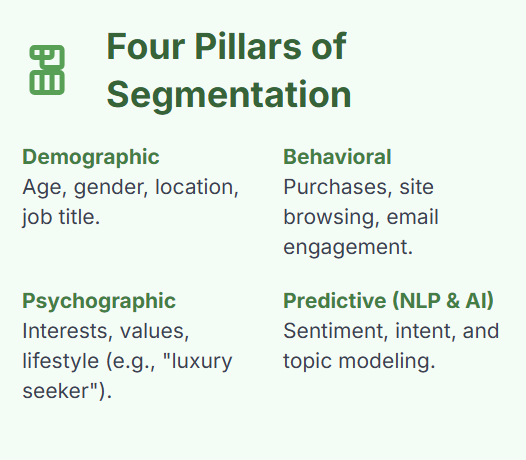Audience Segmentation Strategies: How to Personalize Your Email Campaigns
- Sark Promotions
- Sep 20
- 3 min read
Unlock higher opens, clicks, and conversions by dividing and conquering your list with NLP‑driven precision.
In a nutshell, audience segmentation is the process of dividing your email list into smaller groups based on shared attributes—demographics, behavior, or psychographics—so you can serve each group content that speaks directly to their needs. By layering in Natural Language Processing (NLP) techniques such as sentiment analysis and intent classification, you can automate and refine this process—ensuring your messages land at the right time, with the right tone, and the right call‑to‑action to drive real results.
1. Why Segmentation Matters for Action‑Oriented Campaigns
Higher relevance → higher engagement: Segmented campaigns see up to 760% increase in revenue over non‑segmented ones.
Action intent focus: Deliver messages that prompt users to “Download now,” “Start your trial,” or “Claim your discount” based on predicted intent.
Better deliverability & trust: Sending fewer, more targeted emails reduces unsubscribes and spam complaints.

2. Four Pillars of Effective Segmentation
Demographic Segmentation
Age, gender, location, job title
Customize offers: e.g., “Download our Mumbai Real‑Estate Report” for subscribers in Maharashtra
Behavioral Segmentation
Past purchases, email engagement, site browsing
Triggered flows: abandoned cart reminders, product‑view follow‑ups
Psychographic Segmentation
Interests, values, lifestyle
Use surveys or social‑listening data to assign values like “budget‑conscious” vs. “luxury seeker”
Predictive Segmentation with NLP & AI
Sentiment Analysis: Scan past email replies or support tickets to identify advocates vs. detractors
Intent Classification: Use keyword‑level machine learning to flag “ready to buy” vs. “just researching”
Topic Modeling: Automatically group subscribers by themes in their on‑site searches or survey responses

3. Step‑by‑Step: Implementing NLP‑Powered Segmentation
Collect First‑ and Zero‑Party Data
Use preference centers, short quizzes, and on‑site forms to gather interests and goals.
Enrich with Behavioral Signals
Integrate web analytics and email interaction data into your CRM.
Apply NLP Models
Sentiment Analysis: Run open‑source libraries (e.g., spaCy, NLTK) on subscriber feedback to assign emotional scores.
Intent Detection: Train a simple classifier on your past campaign archive to tag each subscriber’s stage in the buyer journey.
Entity Recognition: Automatically extract key product names or feature requests from support tickets to drive content suggestions.
Define Your Segments
Combine demographic, behavioral, and NLP‑driven labels into logical cohorts (e.g., “High‑Intent Enterprise Prospects” or “Churn‑Risk Budget Shoppers”).
Craft Personalized Flows
Use dynamic content blocks to swap images, copy, and CTAs per segment.
Leverage predicted optimal send times per segment using AI‑based scheduling.
Automate & Test
Set up event‑triggered journeys (welcome series, cart recovery, re‑engagement) in your ESP.
Run A/B tests on subject lines and CTAs within each segment and feed results back into your NLP models for continuous refinement.

4. Tools & Technologies to Get You Started
Category | Example Tools |
ESP with Segmentation | Klaviyo, Mailchimp, ActiveCampaign |
NLP Libraries & Platforms | spaCy, Hugging Face Transformers, Google Cloud NLP |
Customer Data Platforms | Segment, mParticle |
AI‑Powered Add‑ons | Persado (language optimization), Phrasee (subject lines) |
5. SEO & AEO Best Practices
Keyword Focus: Naturally include “audience segmentation strategies,” “personalize email campaigns,” and “NLP email marketing.”
Direct Answer Snippets: Start each section by clearly answering “how” or “why,” so voice assistants and AI engines can extract your content as featured snippets.
Structured Headings (H2/H3): Use question‑style subheadings (e.g., “What Is Predictive Segmentation?”) to align with AEO patterns.
FAQ Schema: Add an FAQ block at the end with concise Q&A to appear in zero‑click results.
Conversational Tone: Write as if you’re coaching a colleague—this matches natural speech used in voice searches.

Frequently Asked Questions
Q1: What is the most effective way to segment my email list?
Start with a hybrid approach: combine demographic and behavioral data, then layer in NLP‑driven sentiment and intent signals to create micro‑segments that receive highly tailored messaging.
Q2: How can I use sentiment analysis in email marketing?
Run sentiment analysis on past survey responses or support emails to classify subscribers as advocates, neutrals, or detractors—then serve each group content designed to amplify positivity or rebuild trust.
Q3: Which NLP model should I choose for intent classification?
Fine‑tune a lightweight transformer (e.g., DistilBERT) on your own campaign data for the best balance of accuracy and speed. Many open‑source tutorials can guide you through this process in under an hour.




Comments